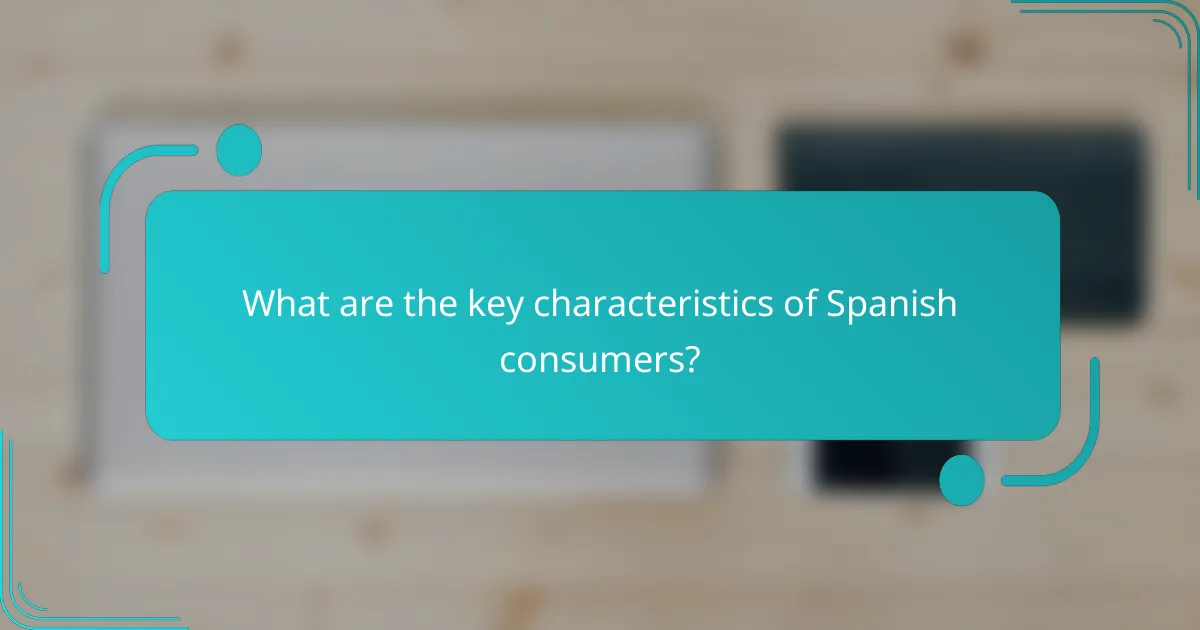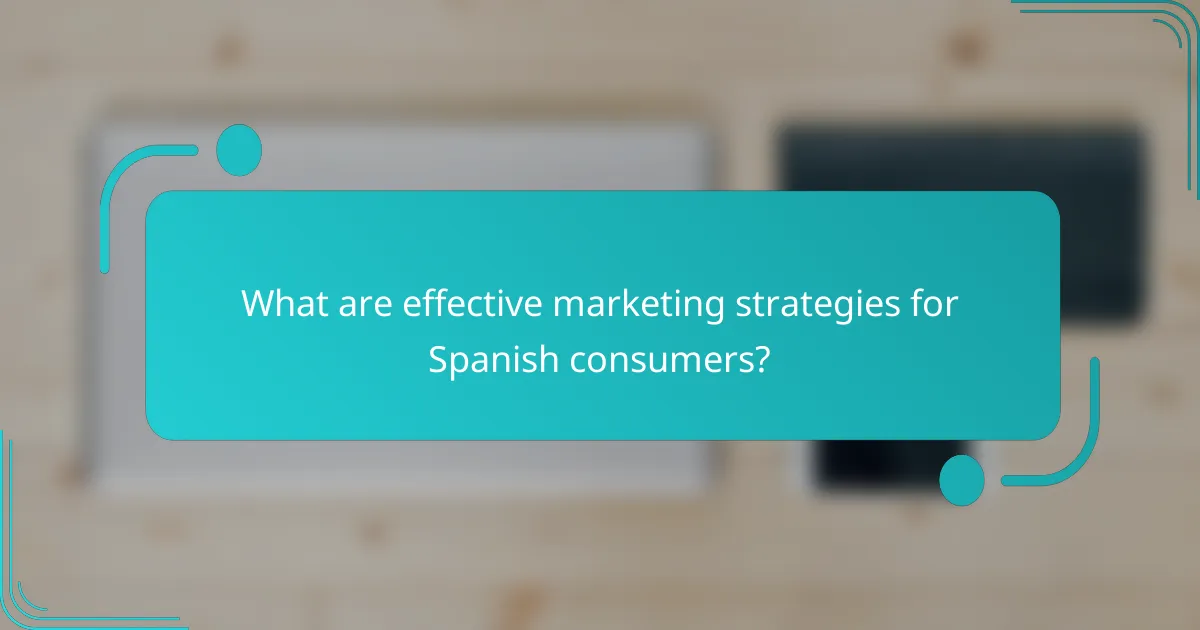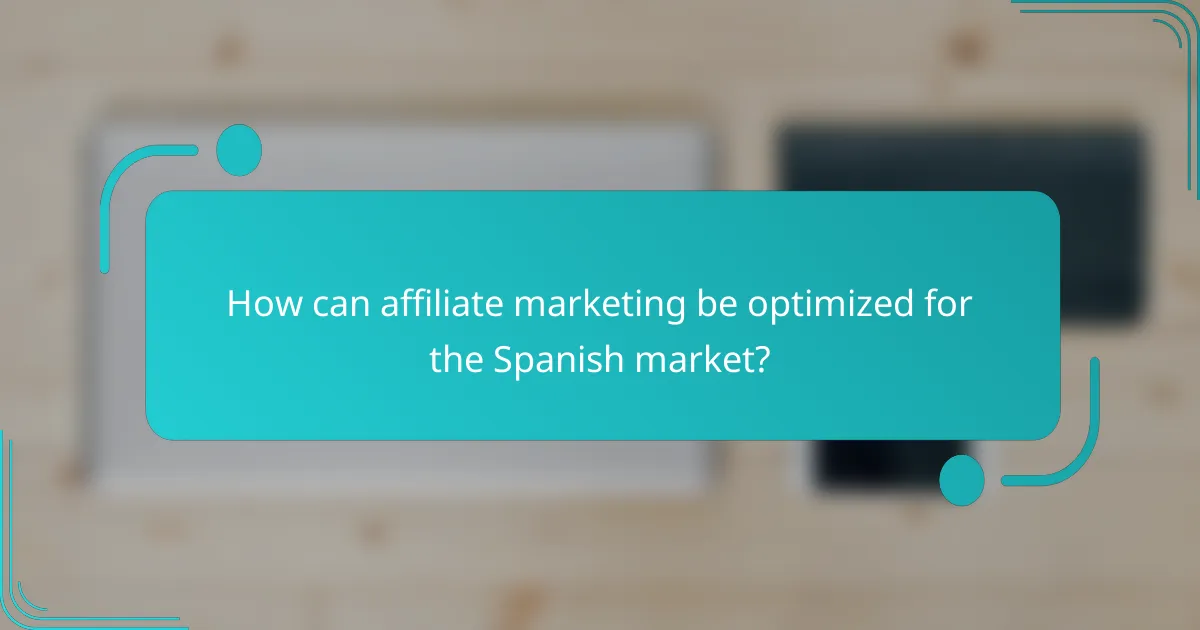Understanding Spanish consumer behavior is crucial for businesses aiming to enhance their conversion rates. By aligning marketing strategies with local preferences, such as a preference for quality and local brands, companies can create campaigns that effectively engage Spanish consumers. Additionally, recognizing the cultural influences on purchasing decisions allows businesses to tailor their approaches, ultimately driving sales and fostering brand loyalty.

How can understanding Spanish consumer behavior increase conversion rates?
Understanding Spanish consumer behavior can significantly boost conversion rates by aligning marketing efforts with local preferences and buying habits. By tailoring strategies to meet the specific needs and desires of Spanish consumers, businesses can create more effective campaigns that resonate and drive sales.
Tailored marketing strategies
To effectively reach Spanish consumers, businesses should develop tailored marketing strategies that reflect local culture and values. This includes using language that resonates, incorporating local customs, and addressing specific consumer pain points. For example, campaigns that highlight family values or community involvement tend to perform well in Spain.
Utilizing data analytics can help identify trends in consumer behavior, allowing businesses to adjust their marketing tactics accordingly. Regularly testing different approaches, such as promotional offers or messaging styles, can lead to higher engagement and conversion rates.
Enhanced customer engagement
Enhancing customer engagement with Spanish consumers involves creating interactive and personalized experiences. Businesses can utilize social media platforms popular in Spain, such as Instagram and Facebook, to foster direct communication and build relationships with their audience. Engaging content, such as polls or contests, can encourage participation and loyalty.
Additionally, providing excellent customer service in Spanish and responding promptly to inquiries can improve trust and satisfaction. Offering loyalty programs that reward repeat purchases can also enhance customer retention and encourage referrals.
Improved product offerings
Improving product offerings to align with Spanish consumer preferences is crucial for increasing conversion rates. Conducting market research to understand local tastes and trends can inform product development and selection. For instance, Spanish consumers may prefer locally sourced products or those that emphasize sustainability.
Regularly soliciting feedback from customers can help businesses refine their offerings. Implementing changes based on consumer insights, such as adjusting flavors in food products or introducing new styles in fashion, can lead to increased sales and customer satisfaction.

What are the key characteristics of Spanish consumers?
Spanish consumers are known for their strong preference for local brands, a keen focus on quality relative to price, and significant engagement with social media. Understanding these traits can help businesses tailor their marketing strategies to enhance conversion rates in Spain.
Preference for local brands
Spanish consumers often favor local brands due to a sense of national pride and trust in domestic products. This preference can be attributed to the perception that local brands better understand the cultural nuances and needs of Spanish customers.
To capitalize on this trend, businesses should emphasize their local roots and community involvement in marketing campaigns. Highlighting local sourcing and production can resonate well with consumers, enhancing brand loyalty.
Value for quality and price
Quality and price are critical factors for Spanish consumers when making purchasing decisions. They tend to seek products that offer good value, balancing cost with durability and performance.
Brands should focus on demonstrating the quality of their offerings through clear messaging and customer testimonials. Providing comparative pricing or showcasing promotions can also attract price-sensitive shoppers while maintaining a perception of quality.
Influence of social media
Social media plays a significant role in shaping the purchasing behavior of Spanish consumers. Platforms like Instagram and Facebook are commonly used for product discovery, reviews, and recommendations.
To effectively engage this audience, brands should maintain an active social media presence, share engaging content, and encourage user-generated reviews. Collaborating with local influencers can further enhance visibility and credibility among potential customers.

How does culture impact purchasing decisions in Spain?
Culture significantly influences purchasing decisions in Spain, shaping consumer preferences and behaviors. Understanding these cultural factors can help businesses tailor their marketing strategies to resonate with Spanish consumers.
Family-oriented shopping habits
In Spain, shopping is often a family affair, with many consumers preferring to shop with relatives or friends. This collective approach can enhance the shopping experience, as decisions are frequently made based on group consensus.
Marketers should consider promoting products that appeal to families or highlight shared experiences. For instance, advertising family-sized products or offering discounts for group purchases can attract this demographic.
Importance of tradition and heritage
Spanish consumers place a high value on tradition and heritage, which can significantly impact their purchasing choices. Products that evoke a sense of cultural identity or are tied to local customs tend to resonate well with buyers.
Businesses should emphasize their connection to Spanish culture in their branding and marketing. For example, showcasing locally sourced ingredients or traditional craftsmanship can enhance appeal and foster trust among consumers.
Seasonal buying patterns
Seasonal events and holidays play a crucial role in shaping buying patterns in Spain. Major celebrations, such as Christmas and Easter, see spikes in consumer spending, particularly on food, gifts, and decorations.
To capitalize on these trends, businesses should plan marketing campaigns around these key dates, offering promotions or themed products that align with seasonal festivities. This approach can drive higher engagement and conversion rates during peak shopping times.

What are effective marketing strategies for Spanish consumers?
Effective marketing strategies for Spanish consumers focus on cultural relevance, local engagement, and digital presence. Tailoring your approach to resonate with Spanish values and preferences can significantly enhance conversion rates.
Localized content marketing
Localized content marketing involves creating marketing materials that reflect the cultural nuances and preferences of Spanish consumers. This means using the Spanish language appropriately and incorporating local references, traditions, and values into your content.
For example, using regional dialects or addressing local holidays can make your content more relatable. Additionally, consider the timing of your campaigns to align with significant local events, which can increase engagement and relevance.
Social media advertising
Social media advertising is crucial for reaching Spanish consumers, as they are highly active on platforms like Facebook, Instagram, and TikTok. Tailoring ads to reflect local culture and trends can improve their effectiveness.
Utilize visually appealing content and consider using local influencers to enhance credibility. A/B testing different ad formats and messages can help identify what resonates best with your target audience.
Influencer partnerships
Influencer partnerships can be a powerful strategy to connect with Spanish consumers. Collaborating with local influencers who align with your brand values can enhance trust and authenticity.
Choose influencers who have a genuine connection with their audience and understand the local market. Establish clear expectations and metrics for success to ensure that the partnership delivers measurable results.

How can affiliate marketing be optimized for the Spanish market?
To optimize affiliate marketing for the Spanish market, focus on understanding local consumer preferences and cultural nuances. Tailoring your strategies to align with these factors can significantly enhance conversion rates.
Targeted affiliate programs
Implementing targeted affiliate programs is crucial for reaching Spanish consumers effectively. Choose affiliates that resonate with local interests, such as fashion influencers for apparel or tech bloggers for electronics. This alignment can lead to higher engagement and conversion rates.
Consider offering incentives that appeal specifically to Spanish audiences, such as discounts during local holidays or promotions tied to regional events. This approach can create a sense of urgency and relevance, driving more traffic to your affiliate links.
Performance tracking and analytics
Effective performance tracking and analytics are essential for optimizing affiliate marketing efforts in Spain. Utilize tools that provide insights into click-through rates, conversion rates, and customer demographics. This data will help you identify which strategies are working and where adjustments are needed.
Regularly analyze the performance of your affiliates to determine which partnerships yield the best results. Focus on metrics that matter most to your goals, such as return on investment (ROI) and customer acquisition cost (CAC), to refine your approach continually.
Collaboration with local affiliates
Collaborating with local affiliates can enhance your brand’s credibility and reach within the Spanish market. Local affiliates understand regional trends and consumer behavior, making them valuable partners in promoting your products or services.
Build strong relationships with these affiliates by providing them with the necessary resources and support. This could include exclusive content, promotional materials, or tailored commission structures that incentivize them to promote your offerings effectively.

What are the challenges in reaching Spanish consumers?
Reaching Spanish consumers presents several challenges, including language barriers, regional differences, and strong competition from established brands. Understanding these factors is crucial for effectively engaging this market and improving conversion rates.
Language barriers
Language barriers can significantly hinder communication with Spanish consumers. While many Spaniards speak English, a substantial portion prefers to engage in their native language, which can affect their purchasing decisions.
To overcome this challenge, businesses should invest in high-quality translations and localize their marketing materials. Utilizing native speakers for customer service and support can also enhance trust and connection with the audience.
Understanding regional differences
Spain is home to diverse regions, each with unique cultural identities and consumer preferences. For instance, consumers in Catalonia may have different tastes and shopping habits compared to those in Andalusia.
Marketers should tailor their strategies to reflect these regional differences. Conducting market research to understand local customs, preferences, and even dialects can lead to more effective campaigns and higher engagement.
Competition from established brands
Established brands dominate the Spanish market, making it challenging for new entrants to gain traction. These brands often have strong loyalty among consumers, which can be difficult to overcome.
To compete effectively, new businesses should focus on unique selling propositions that differentiate their products or services. Building a strong brand presence through social media and local partnerships can also help in gaining visibility and trust among Spanish consumers.
